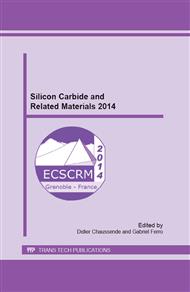p.476
p.480
p.484
p.488
p.492
p.496
p.500
p.504
p.508
Influence of Phosphorous Auto-Doping on the Characteristics of SiO2/SiC Gate Dielectrics
Abstract:
We present the influence of phosphorous auto-doping on the characteristics of the oxide interface in 4H-SiC following high temperature gate oxide annealing. IV characteristics show no evidence of direct tunnelling breakdown; however Fowler Nordheim (F-N) conduction is observed in high electric field with the oxides able to sustain >10MV/cm. Capacitance Voltage data show DIT <1x1012 eV-1cm-2 close to the conduction band edge after POA, with undoped samples demonstrating DIT below 5x1011 eV-1cm-2. Photo CV data indicates smaller flat band voltage shifts of 0.6V at midpoint for the undoped samples, in comparison to 0.9V for the phosphorous doped devices. Temperature and bias stress tests at 200°C showed marginal hysteresis (0.3V) in both wafers. Reliability of time-dependent constant current and constant voltage characteristics revealed higher TDDB lifetimes in the undoped wafer. We conclude that the unintentional incorporation of phosphorous into the gate stack as a result of high temperature POA of the doped field oxide leads to a variation in flat band shift, higher DIT, and lower dielectric reliability.
Info:
Periodical:
Pages:
492-495
Citation:
Online since:
June 2015
Keywords:
Price:
Сopyright:
© 2015 Trans Tech Publications Ltd. All Rights Reserved
Share:
Citation:


